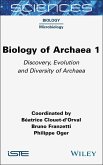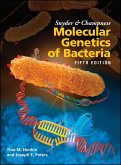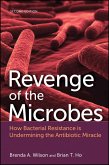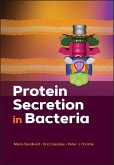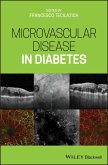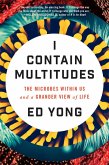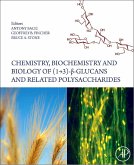Béatrice Clouet-d'Orval, Bruno Franzetti, Philippe Oger
Biology of Archaea, Volume 1 (eBook, ePUB)
Discovery, Evolution and Diversity of Archaea
142,99 €
142,99 €
inkl. MwSt.
Sofort per Download lieferbar

0 °P sammeln
142,99 €
Als Download kaufen

142,99 €
inkl. MwSt.
Sofort per Download lieferbar

0 °P sammeln
Jetzt verschenken
Alle Infos zum eBook verschenken
142,99 €
inkl. MwSt.
Sofort per Download lieferbar
Alle Infos zum eBook verschenken

0 °P sammeln
Béatrice Clouet-d'Orval, Bruno Franzetti, Philippe Oger
Biology of Archaea, Volume 1 (eBook, ePUB)
Discovery, Evolution and Diversity of Archaea
- Format: ePub
- Merkliste
- Auf die Merkliste
- Bewerten Bewerten
- Teilen
- Produkt teilen
- Produkterinnerung
- Produkterinnerung

Bitte loggen Sie sich zunächst in Ihr Kundenkonto ein oder registrieren Sie sich bei
bücher.de, um das eBook-Abo tolino select nutzen zu können.
Hier können Sie sich einloggen
Hier können Sie sich einloggen
Sie sind bereits eingeloggt. Klicken Sie auf 2. tolino select Abo, um fortzufahren.

Bitte loggen Sie sich zunächst in Ihr Kundenkonto ein oder registrieren Sie sich bei bücher.de, um das eBook-Abo tolino select nutzen zu können.
Archaea constitute a new branch of life alongside bacteria and eukaryotes. These microorganisms are unique in their cellular and molecular aspects. They have evolutionary links with the first eukaryotic cells and are now being used to elucidate fundamental biological questions.
Champions of extremophilicity, archaea are helping to lift the veil on the limits of life on Earth. Biology of Archaea 1 explores the discovery and evolution of the field of archaea research.
This book also looks at the evolutionary history of archaea and their integration into the tree of life, and examines this…mehr
- Geräte: eReader
- mit Kopierschutz
- eBook Hilfe
- Größe: 2.66MB
Andere Kunden interessierten sich auch für
![Biology of Archaea, Volume 1 (eBook, PDF) Biology of Archaea, Volume 1 (eBook, PDF)]() Béatrice Clouet-d'OrvalBiology of Archaea, Volume 1 (eBook, PDF)142,99 €
Béatrice Clouet-d'OrvalBiology of Archaea, Volume 1 (eBook, PDF)142,99 €![Snyder and Champness Molecular Genetics of Bacteria (eBook, ePUB) Snyder and Champness Molecular Genetics of Bacteria (eBook, ePUB)]() Tina M. HenkinSnyder and Champness Molecular Genetics of Bacteria (eBook, ePUB)107,99 €
Tina M. HenkinSnyder and Champness Molecular Genetics of Bacteria (eBook, ePUB)107,99 €![Revenge of the Microbes (eBook, ePUB) Revenge of the Microbes (eBook, ePUB)]() Brenda A. WilsonRevenge of the Microbes (eBook, ePUB)23,99 €
Brenda A. WilsonRevenge of the Microbes (eBook, ePUB)23,99 €![Protein Secretion in Bacteria (eBook, ePUB) Protein Secretion in Bacteria (eBook, ePUB)]() Protein Secretion in Bacteria (eBook, ePUB)129,99 €
Protein Secretion in Bacteria (eBook, ePUB)129,99 €![Microvascular Disease in Diabetes (eBook, ePUB) Microvascular Disease in Diabetes (eBook, ePUB)]() Microvascular Disease in Diabetes (eBook, ePUB)169,99 €
Microvascular Disease in Diabetes (eBook, ePUB)169,99 €![I Contain Multitudes (eBook, ePUB) I Contain Multitudes (eBook, ePUB)]() Ed YongI Contain Multitudes (eBook, ePUB)9,79 €
Ed YongI Contain Multitudes (eBook, ePUB)9,79 €![Chemistry, Biochemistry, and Biology of 1-3 Beta Glucans and Related Polysaccharides (eBook, ePUB) Chemistry, Biochemistry, and Biology of 1-3 Beta Glucans and Related Polysaccharides (eBook, ePUB)]() Chemistry, Biochemistry, and Biology of 1-3 Beta Glucans and Related Polysaccharides (eBook, ePUB)74,95 €
Chemistry, Biochemistry, and Biology of 1-3 Beta Glucans and Related Polysaccharides (eBook, ePUB)74,95 €-
-
-
Archaea constitute a new branch of life alongside bacteria and eukaryotes. These microorganisms are unique in their cellular and molecular aspects. They have evolutionary links with the first eukaryotic cells and are now being used to elucidate fundamental biological questions.
Champions of extremophilicity, archaea are helping to lift the veil on the limits of life on Earth. Biology of Archaea 1 explores the discovery and evolution of the field of archaea research.
This book also looks at the evolutionary history of archaea and their integration into the tree of life, and examines this complex and extremely diverse world in terms of their ecological niches and their still largely unexplored virosphere.
Champions of extremophilicity, archaea are helping to lift the veil on the limits of life on Earth. Biology of Archaea 1 explores the discovery and evolution of the field of archaea research.
This book also looks at the evolutionary history of archaea and their integration into the tree of life, and examines this complex and extremely diverse world in terms of their ecological niches and their still largely unexplored virosphere.
Dieser Download kann aus rechtlichen Gründen nur mit Rechnungsadresse in D ausgeliefert werden.
Produktdetails
- Produktdetails
- Verlag: For Dummies
- Seitenzahl: 436
- Erscheinungstermin: 17. Januar 2025
- Englisch
- ISBN-13: 9781394351831
- Artikelnr.: 72871288
- Verlag: For Dummies
- Seitenzahl: 436
- Erscheinungstermin: 17. Januar 2025
- Englisch
- ISBN-13: 9781394351831
- Artikelnr.: 72871288
- Herstellerkennzeichnung Die Herstellerinformationen sind derzeit nicht verfügbar.
Béatrice Clouet-d'Orval is Research Director at the CNRS and works at the Center for Integrative Biology, Toulouse, France. Her main research areas focus on the post-transcriptional regulation of gene expression.
Bruno Franzetti is Research Director at the CNRS, France, where he specializes in the structural biology of archaea. His research areas include biophysical and cellular mechanisms that maintain proteome integrity under extreme conditions.
Philippe Oger is Research Director at the CNRS, France. His research areas include understanding the adaptations of prokaryotes in response to extreme conditions, using a multidisciplinary approach combining the methods derived from atomic physics and cutting-edge molecular biology and modeling.
Bruno Franzetti is Research Director at the CNRS, France, where he specializes in the structural biology of archaea. His research areas include biophysical and cellular mechanisms that maintain proteome integrity under extreme conditions.
Philippe Oger is Research Director at the CNRS, France. His research areas include understanding the adaptations of prokaryotes in response to extreme conditions, using a multidisciplinary approach combining the methods derived from atomic physics and cutting-edge molecular biology and modeling.
Preface xi
Béatrice CLOUET-D'ORVAL, Bruno FRANZETTI and Philippe OGER
Chapter 1. The Discovery of Archaea 1
Patrick FORTERRE
1.1. Introduction 1
1.2. Prokaryotic-eukaryotic dichotomy 2
1.3. Two domains for prokaryotes: archaebacteria and eubacteria 3
1.3.1. Ribosomal RNA as a molecular marker: a historical choice 3
1.3.2. Atypical ribosomal RNA of methanogenic "bacteria" 7
1.3.3. The concept of archaeobacteria 8
1.3.4. The grouping of halophilic and thermo-acidophilic "bacteria" with
methanogens within archaeobacteria 9
1.4. The living trilogy 11
1.4.1. The concept of archaeobacteria confirmed by the uniqueness of their
membrane phospholipids 11
1.4.2. German biochemists: champions of the archaeobacteria concept 12
1.4.3. The evolutionary link between archaeobacteria and eukaryotes and the
introduction of the term archaea 13
1.5. Archaea and high-temperature living 14
1.5.1. The discovery of anaerobic hyperthermophilic archaea 14
1.5.2. The race for the thermophilia record 18
1.5.3. The discovery of viruses in hyperthermophilic archaea 20
1.6. Non-extremophilic archaea discovered by molecular ecology: a new
vision of the third domain 22
1.7. Conclusion 23
1.8. References 24
Chapter 2. Evolution of Archaea and Their Taxonomy 29
Patrick FORTERRE
2.1. Introduction 29
2.2. One domain, three major branches and a few isolated "phyla" 30
2.2.1. One domain, two phyla 30
2.2.2. A first orphaned phylum, the korarchaeota. 31
2.2.3. The first phylogenies based on conserved proteins 32
2.2.4. The special case of Methanopyrus kandleri 35
2.2.5. The special case of Nanoarchaeum equitans 36
2.2.6. Thaumarchaea 37
2.3. From phyla to superphyla 39
2.3.1. Metagenomics and the explosion in the number of archaeal phyla 39
2.3.2. The superphylum TACK 41
2.3.3. The DPANN 45
2.3.4. The Asgard archaea 50
2.3.5. Stygia/Hadarchaeota 55
2.3.6. Hydrothermarchaeota 55
2.4. Euryarchaea. 56
2.4.1. Group I Euryarchaea 57
2.4.2. Group II Euryarchaea. 59
2.5. A new nomenclature for the taxonomy of archaea? 64
2.6. Reconstructing the last common ancestor of archaea: LACA 67
2.6.1. Rooting the archaeal tree. 67
2.6.2. Two opposing visions of LACA: simple or complex 71
2.6.3. The likely hyperthermophilic nature of LACA. 72
2.6.4. The possibility of a methanogenic LACA 74
2.7. Conclusion 76
2.8. References 76
Chapter 3. Archaea and the Tree of Life 89
Patrick FORTERRE
3.1. Introduction 89
3.2. The progenote concept 90
3.3. Archaea: prokaryotes related to eukaryotes 91
3.4. Rooting the universal tree 92
3.5. The nature of LUCA 97
3.5.1. A simpler LUCA compared to the organisms of the three current
domains 97
3.5.2. An RNA genome for LUCA? 97
3.5.3. A presumably mesophilic LUCA 100
3.5.4. LUCA's proteome 105
3.6. The topology of the universal tree under debate 110
3.6.1. Early challenge to the Woese tree: the eocyte hypothesis 110
3.6.2. Searching for the archean ancestor of eukaryotes 111
3.6.3. Discovery of the Asgard archaea: validation of the 2D hypothesis?
112
3.6.4. Controversies over the position of Asgard archaea 113
3.7. The origin of new eukaryotic-like proteins discovered in Asgard
archaea 125
3.8. Asgard archaea and the origin of eukaryotes 130
3.8.1. Asgard archaea at the origin of eukaryotes: a new paradigm 130
3.8.2. The inside-out model based on nanotubes discovered in Asgard archaea
131
3.8.3. The two-bacteria 2D model 132
3.8.4. The origin of eukaryotic cell complexity 132
3.9. The biological issues posed by the 2D model 133
3.10. Viruses and the universal tree of life 136
3.11. Conclusion 141
3.12. References 141
Chapter 4. Archaea: Habitats and Associated Physiologies 153
Karine ALAIN, Marc COZANNET, Maxime ALLIOUX, Sarah THIROUX and Jordan
HARTUNIANS
4.1. Introduction 153
4.2. Archaea of extreme habitats: extremophiles 156
4.2.1. Psychrophiles 158
4.2.2. Thermophiles/hyperthermophiles 161
4.2.3. Acidophiles 164
4.2.4. Alkalophiles 166
4.2.5. Halophiles 167
4.2.6. Piezophiles 168
4.2.7. Radiotolerant archaea 169
4.2.8. Poly-extremophilic archaea 170
4.2.9. Record-holding archaea 171
4.3. Archaea populating ordinary, non-extreme environments 172
4.3.1. Phytobiomes, rice paddies and peatlands 174
4.3.2. Aquatic habitats: lakes, oceans and estuaries 178
4.3.3. Environments linked to human activities: example of waste treatment
and anaerobic digesters (methanizers) 183
4.3.4. Animal microbiomes 185
4.4. Archaea resistant to cultivation efforts 188
4.5. Challenges and success stories 191
4.6. Conclusion 193
4.7. References 193
Chapter 5. Methanogenic Archaea 205
Tristan WAGNER, Laurent TOFFIN and Guillaume BORREL
5.1. Diversity of methanogens and their environments 205
5.1.1. Methane sources and sinks 205
5.1.2. Taxonomic and metabolic diversity 207
5.1.3. Ecological diversity of methanogens 210
5.2. Interactions of methanogens with their environment 216
5.2.1. Competition for substrates 216
5.2.2. Ecological and syntrophic interactions 217
5.2.3. Human-methanogen association 218
5.3. Bioenergetics and biochemistry of methanogenesis 219
5.3.1. Energy extremophiles 219
5.3.2. Cofactors used in methanogenesis 219
5.3.3. Different types of methanogenesis 222
5.3.4. MCR, the unique enzyme capable of generating biogenic methane 230
5.4. Anaerobic methanotrophs and anaerobic oxidation of multi-carbon
alkanes 232
5.5. Evolution of methanogenesis 233
5.5.1. An ancestral metabolism 233
5.5.2. Metabolic adaptations 234
5.6. The impact of methanogens in our modern society 234
5.7. References 236
Chapter 6. Hyperthermophilic Archaeal Viruses 247
Diana BAQUERO, Mart KRUPOVIC, Claire GESLIN and David PRANGISHVILI
6.1. Introduction 247
6.2. Morphological and structural diversity 248
6.2.1. Viruses with unique morphologies: families Ampullaviridae,
Spiraviridae and Guttaviridae 248
6.2.2. Filamentous viruses: families Rudiviridae, Lipothrixviridae,
Tristromaviridae and Clavaviridae 249
6.2.3. Spherical and icosahedral viruses: families Globuloviridae,
Ovaliviridae, Portogloboviridae and Turriviridae 251
6.2.4. Fusiform viruses: families Fuselloviridae and Bicaudoviridae 253
6.3. Genomic features of hyperthermophilic archaeal viruses 254
6.3.1. Genome content 254
6.3.2. Structural genomics 257
6.4. Virus-host interactions 258
6.4.1. Virus entry 259
6.4.2. Virion egress 259
6.5. Conclusions 260
6.6. References 261
List of Authors 269
Index 271
Béatrice CLOUET-D'ORVAL, Bruno FRANZETTI and Philippe OGER
Chapter 1. The Discovery of Archaea 1
Patrick FORTERRE
1.1. Introduction 1
1.2. Prokaryotic-eukaryotic dichotomy 2
1.3. Two domains for prokaryotes: archaebacteria and eubacteria 3
1.3.1. Ribosomal RNA as a molecular marker: a historical choice 3
1.3.2. Atypical ribosomal RNA of methanogenic "bacteria" 7
1.3.3. The concept of archaeobacteria 8
1.3.4. The grouping of halophilic and thermo-acidophilic "bacteria" with
methanogens within archaeobacteria 9
1.4. The living trilogy 11
1.4.1. The concept of archaeobacteria confirmed by the uniqueness of their
membrane phospholipids 11
1.4.2. German biochemists: champions of the archaeobacteria concept 12
1.4.3. The evolutionary link between archaeobacteria and eukaryotes and the
introduction of the term archaea 13
1.5. Archaea and high-temperature living 14
1.5.1. The discovery of anaerobic hyperthermophilic archaea 14
1.5.2. The race for the thermophilia record 18
1.5.3. The discovery of viruses in hyperthermophilic archaea 20
1.6. Non-extremophilic archaea discovered by molecular ecology: a new
vision of the third domain 22
1.7. Conclusion 23
1.8. References 24
Chapter 2. Evolution of Archaea and Their Taxonomy 29
Patrick FORTERRE
2.1. Introduction 29
2.2. One domain, three major branches and a few isolated "phyla" 30
2.2.1. One domain, two phyla 30
2.2.2. A first orphaned phylum, the korarchaeota. 31
2.2.3. The first phylogenies based on conserved proteins 32
2.2.4. The special case of Methanopyrus kandleri 35
2.2.5. The special case of Nanoarchaeum equitans 36
2.2.6. Thaumarchaea 37
2.3. From phyla to superphyla 39
2.3.1. Metagenomics and the explosion in the number of archaeal phyla 39
2.3.2. The superphylum TACK 41
2.3.3. The DPANN 45
2.3.4. The Asgard archaea 50
2.3.5. Stygia/Hadarchaeota 55
2.3.6. Hydrothermarchaeota 55
2.4. Euryarchaea. 56
2.4.1. Group I Euryarchaea 57
2.4.2. Group II Euryarchaea. 59
2.5. A new nomenclature for the taxonomy of archaea? 64
2.6. Reconstructing the last common ancestor of archaea: LACA 67
2.6.1. Rooting the archaeal tree. 67
2.6.2. Two opposing visions of LACA: simple or complex 71
2.6.3. The likely hyperthermophilic nature of LACA. 72
2.6.4. The possibility of a methanogenic LACA 74
2.7. Conclusion 76
2.8. References 76
Chapter 3. Archaea and the Tree of Life 89
Patrick FORTERRE
3.1. Introduction 89
3.2. The progenote concept 90
3.3. Archaea: prokaryotes related to eukaryotes 91
3.4. Rooting the universal tree 92
3.5. The nature of LUCA 97
3.5.1. A simpler LUCA compared to the organisms of the three current
domains 97
3.5.2. An RNA genome for LUCA? 97
3.5.3. A presumably mesophilic LUCA 100
3.5.4. LUCA's proteome 105
3.6. The topology of the universal tree under debate 110
3.6.1. Early challenge to the Woese tree: the eocyte hypothesis 110
3.6.2. Searching for the archean ancestor of eukaryotes 111
3.6.3. Discovery of the Asgard archaea: validation of the 2D hypothesis?
112
3.6.4. Controversies over the position of Asgard archaea 113
3.7. The origin of new eukaryotic-like proteins discovered in Asgard
archaea 125
3.8. Asgard archaea and the origin of eukaryotes 130
3.8.1. Asgard archaea at the origin of eukaryotes: a new paradigm 130
3.8.2. The inside-out model based on nanotubes discovered in Asgard archaea
131
3.8.3. The two-bacteria 2D model 132
3.8.4. The origin of eukaryotic cell complexity 132
3.9. The biological issues posed by the 2D model 133
3.10. Viruses and the universal tree of life 136
3.11. Conclusion 141
3.12. References 141
Chapter 4. Archaea: Habitats and Associated Physiologies 153
Karine ALAIN, Marc COZANNET, Maxime ALLIOUX, Sarah THIROUX and Jordan
HARTUNIANS
4.1. Introduction 153
4.2. Archaea of extreme habitats: extremophiles 156
4.2.1. Psychrophiles 158
4.2.2. Thermophiles/hyperthermophiles 161
4.2.3. Acidophiles 164
4.2.4. Alkalophiles 166
4.2.5. Halophiles 167
4.2.6. Piezophiles 168
4.2.7. Radiotolerant archaea 169
4.2.8. Poly-extremophilic archaea 170
4.2.9. Record-holding archaea 171
4.3. Archaea populating ordinary, non-extreme environments 172
4.3.1. Phytobiomes, rice paddies and peatlands 174
4.3.2. Aquatic habitats: lakes, oceans and estuaries 178
4.3.3. Environments linked to human activities: example of waste treatment
and anaerobic digesters (methanizers) 183
4.3.4. Animal microbiomes 185
4.4. Archaea resistant to cultivation efforts 188
4.5. Challenges and success stories 191
4.6. Conclusion 193
4.7. References 193
Chapter 5. Methanogenic Archaea 205
Tristan WAGNER, Laurent TOFFIN and Guillaume BORREL
5.1. Diversity of methanogens and their environments 205
5.1.1. Methane sources and sinks 205
5.1.2. Taxonomic and metabolic diversity 207
5.1.3. Ecological diversity of methanogens 210
5.2. Interactions of methanogens with their environment 216
5.2.1. Competition for substrates 216
5.2.2. Ecological and syntrophic interactions 217
5.2.3. Human-methanogen association 218
5.3. Bioenergetics and biochemistry of methanogenesis 219
5.3.1. Energy extremophiles 219
5.3.2. Cofactors used in methanogenesis 219
5.3.3. Different types of methanogenesis 222
5.3.4. MCR, the unique enzyme capable of generating biogenic methane 230
5.4. Anaerobic methanotrophs and anaerobic oxidation of multi-carbon
alkanes 232
5.5. Evolution of methanogenesis 233
5.5.1. An ancestral metabolism 233
5.5.2. Metabolic adaptations 234
5.6. The impact of methanogens in our modern society 234
5.7. References 236
Chapter 6. Hyperthermophilic Archaeal Viruses 247
Diana BAQUERO, Mart KRUPOVIC, Claire GESLIN and David PRANGISHVILI
6.1. Introduction 247
6.2. Morphological and structural diversity 248
6.2.1. Viruses with unique morphologies: families Ampullaviridae,
Spiraviridae and Guttaviridae 248
6.2.2. Filamentous viruses: families Rudiviridae, Lipothrixviridae,
Tristromaviridae and Clavaviridae 249
6.2.3. Spherical and icosahedral viruses: families Globuloviridae,
Ovaliviridae, Portogloboviridae and Turriviridae 251
6.2.4. Fusiform viruses: families Fuselloviridae and Bicaudoviridae 253
6.3. Genomic features of hyperthermophilic archaeal viruses 254
6.3.1. Genome content 254
6.3.2. Structural genomics 257
6.4. Virus-host interactions 258
6.4.1. Virus entry 259
6.4.2. Virion egress 259
6.5. Conclusions 260
6.6. References 261
List of Authors 269
Index 271
Preface xi
Béatrice CLOUET-D'ORVAL, Bruno FRANZETTI and Philippe OGER
Chapter 1. The Discovery of Archaea 1
Patrick FORTERRE
1.1. Introduction 1
1.2. Prokaryotic-eukaryotic dichotomy 2
1.3. Two domains for prokaryotes: archaebacteria and eubacteria 3
1.3.1. Ribosomal RNA as a molecular marker: a historical choice 3
1.3.2. Atypical ribosomal RNA of methanogenic "bacteria" 7
1.3.3. The concept of archaeobacteria 8
1.3.4. The grouping of halophilic and thermo-acidophilic "bacteria" with
methanogens within archaeobacteria 9
1.4. The living trilogy 11
1.4.1. The concept of archaeobacteria confirmed by the uniqueness of their
membrane phospholipids 11
1.4.2. German biochemists: champions of the archaeobacteria concept 12
1.4.3. The evolutionary link between archaeobacteria and eukaryotes and the
introduction of the term archaea 13
1.5. Archaea and high-temperature living 14
1.5.1. The discovery of anaerobic hyperthermophilic archaea 14
1.5.2. The race for the thermophilia record 18
1.5.3. The discovery of viruses in hyperthermophilic archaea 20
1.6. Non-extremophilic archaea discovered by molecular ecology: a new
vision of the third domain 22
1.7. Conclusion 23
1.8. References 24
Chapter 2. Evolution of Archaea and Their Taxonomy 29
Patrick FORTERRE
2.1. Introduction 29
2.2. One domain, three major branches and a few isolated "phyla" 30
2.2.1. One domain, two phyla 30
2.2.2. A first orphaned phylum, the korarchaeota. 31
2.2.3. The first phylogenies based on conserved proteins 32
2.2.4. The special case of Methanopyrus kandleri 35
2.2.5. The special case of Nanoarchaeum equitans 36
2.2.6. Thaumarchaea 37
2.3. From phyla to superphyla 39
2.3.1. Metagenomics and the explosion in the number of archaeal phyla 39
2.3.2. The superphylum TACK 41
2.3.3. The DPANN 45
2.3.4. The Asgard archaea 50
2.3.5. Stygia/Hadarchaeota 55
2.3.6. Hydrothermarchaeota 55
2.4. Euryarchaea. 56
2.4.1. Group I Euryarchaea 57
2.4.2. Group II Euryarchaea. 59
2.5. A new nomenclature for the taxonomy of archaea? 64
2.6. Reconstructing the last common ancestor of archaea: LACA 67
2.6.1. Rooting the archaeal tree. 67
2.6.2. Two opposing visions of LACA: simple or complex 71
2.6.3. The likely hyperthermophilic nature of LACA. 72
2.6.4. The possibility of a methanogenic LACA 74
2.7. Conclusion 76
2.8. References 76
Chapter 3. Archaea and the Tree of Life 89
Patrick FORTERRE
3.1. Introduction 89
3.2. The progenote concept 90
3.3. Archaea: prokaryotes related to eukaryotes 91
3.4. Rooting the universal tree 92
3.5. The nature of LUCA 97
3.5.1. A simpler LUCA compared to the organisms of the three current
domains 97
3.5.2. An RNA genome for LUCA? 97
3.5.3. A presumably mesophilic LUCA 100
3.5.4. LUCA's proteome 105
3.6. The topology of the universal tree under debate 110
3.6.1. Early challenge to the Woese tree: the eocyte hypothesis 110
3.6.2. Searching for the archean ancestor of eukaryotes 111
3.6.3. Discovery of the Asgard archaea: validation of the 2D hypothesis?
112
3.6.4. Controversies over the position of Asgard archaea 113
3.7. The origin of new eukaryotic-like proteins discovered in Asgard
archaea 125
3.8. Asgard archaea and the origin of eukaryotes 130
3.8.1. Asgard archaea at the origin of eukaryotes: a new paradigm 130
3.8.2. The inside-out model based on nanotubes discovered in Asgard archaea
131
3.8.3. The two-bacteria 2D model 132
3.8.4. The origin of eukaryotic cell complexity 132
3.9. The biological issues posed by the 2D model 133
3.10. Viruses and the universal tree of life 136
3.11. Conclusion 141
3.12. References 141
Chapter 4. Archaea: Habitats and Associated Physiologies 153
Karine ALAIN, Marc COZANNET, Maxime ALLIOUX, Sarah THIROUX and Jordan
HARTUNIANS
4.1. Introduction 153
4.2. Archaea of extreme habitats: extremophiles 156
4.2.1. Psychrophiles 158
4.2.2. Thermophiles/hyperthermophiles 161
4.2.3. Acidophiles 164
4.2.4. Alkalophiles 166
4.2.5. Halophiles 167
4.2.6. Piezophiles 168
4.2.7. Radiotolerant archaea 169
4.2.8. Poly-extremophilic archaea 170
4.2.9. Record-holding archaea 171
4.3. Archaea populating ordinary, non-extreme environments 172
4.3.1. Phytobiomes, rice paddies and peatlands 174
4.3.2. Aquatic habitats: lakes, oceans and estuaries 178
4.3.3. Environments linked to human activities: example of waste treatment
and anaerobic digesters (methanizers) 183
4.3.4. Animal microbiomes 185
4.4. Archaea resistant to cultivation efforts 188
4.5. Challenges and success stories 191
4.6. Conclusion 193
4.7. References 193
Chapter 5. Methanogenic Archaea 205
Tristan WAGNER, Laurent TOFFIN and Guillaume BORREL
5.1. Diversity of methanogens and their environments 205
5.1.1. Methane sources and sinks 205
5.1.2. Taxonomic and metabolic diversity 207
5.1.3. Ecological diversity of methanogens 210
5.2. Interactions of methanogens with their environment 216
5.2.1. Competition for substrates 216
5.2.2. Ecological and syntrophic interactions 217
5.2.3. Human-methanogen association 218
5.3. Bioenergetics and biochemistry of methanogenesis 219
5.3.1. Energy extremophiles 219
5.3.2. Cofactors used in methanogenesis 219
5.3.3. Different types of methanogenesis 222
5.3.4. MCR, the unique enzyme capable of generating biogenic methane 230
5.4. Anaerobic methanotrophs and anaerobic oxidation of multi-carbon
alkanes 232
5.5. Evolution of methanogenesis 233
5.5.1. An ancestral metabolism 233
5.5.2. Metabolic adaptations 234
5.6. The impact of methanogens in our modern society 234
5.7. References 236
Chapter 6. Hyperthermophilic Archaeal Viruses 247
Diana BAQUERO, Mart KRUPOVIC, Claire GESLIN and David PRANGISHVILI
6.1. Introduction 247
6.2. Morphological and structural diversity 248
6.2.1. Viruses with unique morphologies: families Ampullaviridae,
Spiraviridae and Guttaviridae 248
6.2.2. Filamentous viruses: families Rudiviridae, Lipothrixviridae,
Tristromaviridae and Clavaviridae 249
6.2.3. Spherical and icosahedral viruses: families Globuloviridae,
Ovaliviridae, Portogloboviridae and Turriviridae 251
6.2.4. Fusiform viruses: families Fuselloviridae and Bicaudoviridae 253
6.3. Genomic features of hyperthermophilic archaeal viruses 254
6.3.1. Genome content 254
6.3.2. Structural genomics 257
6.4. Virus-host interactions 258
6.4.1. Virus entry 259
6.4.2. Virion egress 259
6.5. Conclusions 260
6.6. References 261
List of Authors 269
Index 271
Béatrice CLOUET-D'ORVAL, Bruno FRANZETTI and Philippe OGER
Chapter 1. The Discovery of Archaea 1
Patrick FORTERRE
1.1. Introduction 1
1.2. Prokaryotic-eukaryotic dichotomy 2
1.3. Two domains for prokaryotes: archaebacteria and eubacteria 3
1.3.1. Ribosomal RNA as a molecular marker: a historical choice 3
1.3.2. Atypical ribosomal RNA of methanogenic "bacteria" 7
1.3.3. The concept of archaeobacteria 8
1.3.4. The grouping of halophilic and thermo-acidophilic "bacteria" with
methanogens within archaeobacteria 9
1.4. The living trilogy 11
1.4.1. The concept of archaeobacteria confirmed by the uniqueness of their
membrane phospholipids 11
1.4.2. German biochemists: champions of the archaeobacteria concept 12
1.4.3. The evolutionary link between archaeobacteria and eukaryotes and the
introduction of the term archaea 13
1.5. Archaea and high-temperature living 14
1.5.1. The discovery of anaerobic hyperthermophilic archaea 14
1.5.2. The race for the thermophilia record 18
1.5.3. The discovery of viruses in hyperthermophilic archaea 20
1.6. Non-extremophilic archaea discovered by molecular ecology: a new
vision of the third domain 22
1.7. Conclusion 23
1.8. References 24
Chapter 2. Evolution of Archaea and Their Taxonomy 29
Patrick FORTERRE
2.1. Introduction 29
2.2. One domain, three major branches and a few isolated "phyla" 30
2.2.1. One domain, two phyla 30
2.2.2. A first orphaned phylum, the korarchaeota. 31
2.2.3. The first phylogenies based on conserved proteins 32
2.2.4. The special case of Methanopyrus kandleri 35
2.2.5. The special case of Nanoarchaeum equitans 36
2.2.6. Thaumarchaea 37
2.3. From phyla to superphyla 39
2.3.1. Metagenomics and the explosion in the number of archaeal phyla 39
2.3.2. The superphylum TACK 41
2.3.3. The DPANN 45
2.3.4. The Asgard archaea 50
2.3.5. Stygia/Hadarchaeota 55
2.3.6. Hydrothermarchaeota 55
2.4. Euryarchaea. 56
2.4.1. Group I Euryarchaea 57
2.4.2. Group II Euryarchaea. 59
2.5. A new nomenclature for the taxonomy of archaea? 64
2.6. Reconstructing the last common ancestor of archaea: LACA 67
2.6.1. Rooting the archaeal tree. 67
2.6.2. Two opposing visions of LACA: simple or complex 71
2.6.3. The likely hyperthermophilic nature of LACA. 72
2.6.4. The possibility of a methanogenic LACA 74
2.7. Conclusion 76
2.8. References 76
Chapter 3. Archaea and the Tree of Life 89
Patrick FORTERRE
3.1. Introduction 89
3.2. The progenote concept 90
3.3. Archaea: prokaryotes related to eukaryotes 91
3.4. Rooting the universal tree 92
3.5. The nature of LUCA 97
3.5.1. A simpler LUCA compared to the organisms of the three current
domains 97
3.5.2. An RNA genome for LUCA? 97
3.5.3. A presumably mesophilic LUCA 100
3.5.4. LUCA's proteome 105
3.6. The topology of the universal tree under debate 110
3.6.1. Early challenge to the Woese tree: the eocyte hypothesis 110
3.6.2. Searching for the archean ancestor of eukaryotes 111
3.6.3. Discovery of the Asgard archaea: validation of the 2D hypothesis?
112
3.6.4. Controversies over the position of Asgard archaea 113
3.7. The origin of new eukaryotic-like proteins discovered in Asgard
archaea 125
3.8. Asgard archaea and the origin of eukaryotes 130
3.8.1. Asgard archaea at the origin of eukaryotes: a new paradigm 130
3.8.2. The inside-out model based on nanotubes discovered in Asgard archaea
131
3.8.3. The two-bacteria 2D model 132
3.8.4. The origin of eukaryotic cell complexity 132
3.9. The biological issues posed by the 2D model 133
3.10. Viruses and the universal tree of life 136
3.11. Conclusion 141
3.12. References 141
Chapter 4. Archaea: Habitats and Associated Physiologies 153
Karine ALAIN, Marc COZANNET, Maxime ALLIOUX, Sarah THIROUX and Jordan
HARTUNIANS
4.1. Introduction 153
4.2. Archaea of extreme habitats: extremophiles 156
4.2.1. Psychrophiles 158
4.2.2. Thermophiles/hyperthermophiles 161
4.2.3. Acidophiles 164
4.2.4. Alkalophiles 166
4.2.5. Halophiles 167
4.2.6. Piezophiles 168
4.2.7. Radiotolerant archaea 169
4.2.8. Poly-extremophilic archaea 170
4.2.9. Record-holding archaea 171
4.3. Archaea populating ordinary, non-extreme environments 172
4.3.1. Phytobiomes, rice paddies and peatlands 174
4.3.2. Aquatic habitats: lakes, oceans and estuaries 178
4.3.3. Environments linked to human activities: example of waste treatment
and anaerobic digesters (methanizers) 183
4.3.4. Animal microbiomes 185
4.4. Archaea resistant to cultivation efforts 188
4.5. Challenges and success stories 191
4.6. Conclusion 193
4.7. References 193
Chapter 5. Methanogenic Archaea 205
Tristan WAGNER, Laurent TOFFIN and Guillaume BORREL
5.1. Diversity of methanogens and their environments 205
5.1.1. Methane sources and sinks 205
5.1.2. Taxonomic and metabolic diversity 207
5.1.3. Ecological diversity of methanogens 210
5.2. Interactions of methanogens with their environment 216
5.2.1. Competition for substrates 216
5.2.2. Ecological and syntrophic interactions 217
5.2.3. Human-methanogen association 218
5.3. Bioenergetics and biochemistry of methanogenesis 219
5.3.1. Energy extremophiles 219
5.3.2. Cofactors used in methanogenesis 219
5.3.3. Different types of methanogenesis 222
5.3.4. MCR, the unique enzyme capable of generating biogenic methane 230
5.4. Anaerobic methanotrophs and anaerobic oxidation of multi-carbon
alkanes 232
5.5. Evolution of methanogenesis 233
5.5.1. An ancestral metabolism 233
5.5.2. Metabolic adaptations 234
5.6. The impact of methanogens in our modern society 234
5.7. References 236
Chapter 6. Hyperthermophilic Archaeal Viruses 247
Diana BAQUERO, Mart KRUPOVIC, Claire GESLIN and David PRANGISHVILI
6.1. Introduction 247
6.2. Morphological and structural diversity 248
6.2.1. Viruses with unique morphologies: families Ampullaviridae,
Spiraviridae and Guttaviridae 248
6.2.2. Filamentous viruses: families Rudiviridae, Lipothrixviridae,
Tristromaviridae and Clavaviridae 249
6.2.3. Spherical and icosahedral viruses: families Globuloviridae,
Ovaliviridae, Portogloboviridae and Turriviridae 251
6.2.4. Fusiform viruses: families Fuselloviridae and Bicaudoviridae 253
6.3. Genomic features of hyperthermophilic archaeal viruses 254
6.3.1. Genome content 254
6.3.2. Structural genomics 257
6.4. Virus-host interactions 258
6.4.1. Virus entry 259
6.4.2. Virion egress 259
6.5. Conclusions 260
6.6. References 261
List of Authors 269
Index 271

